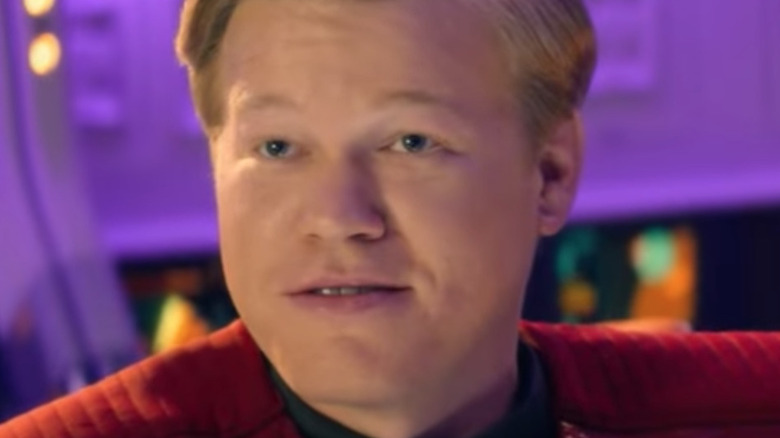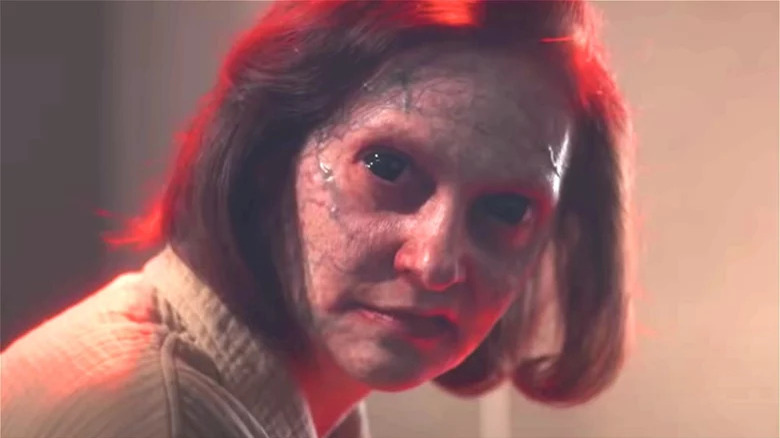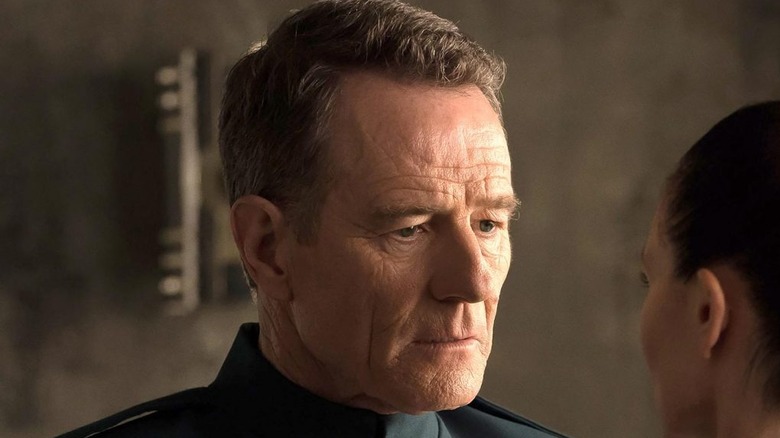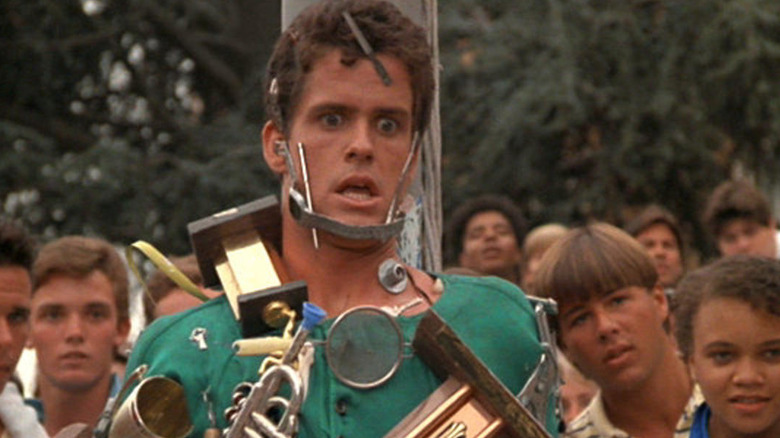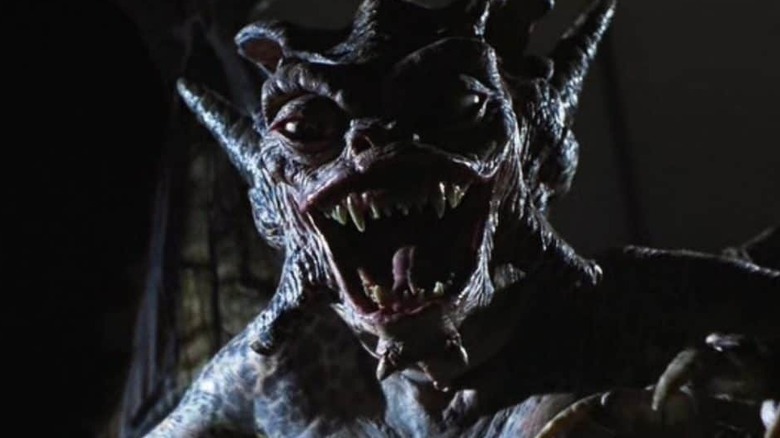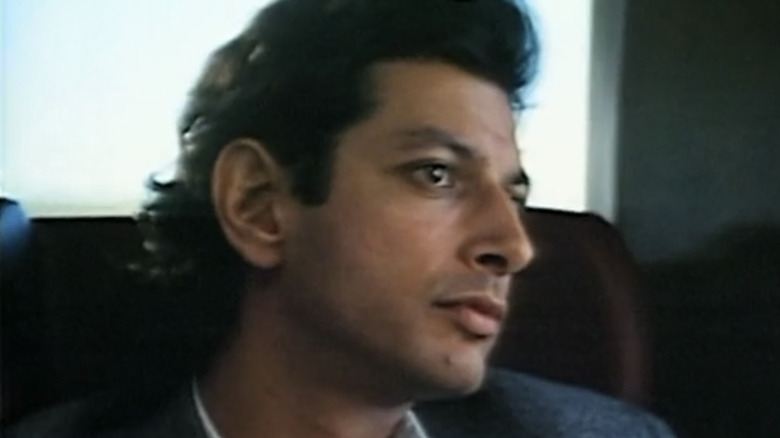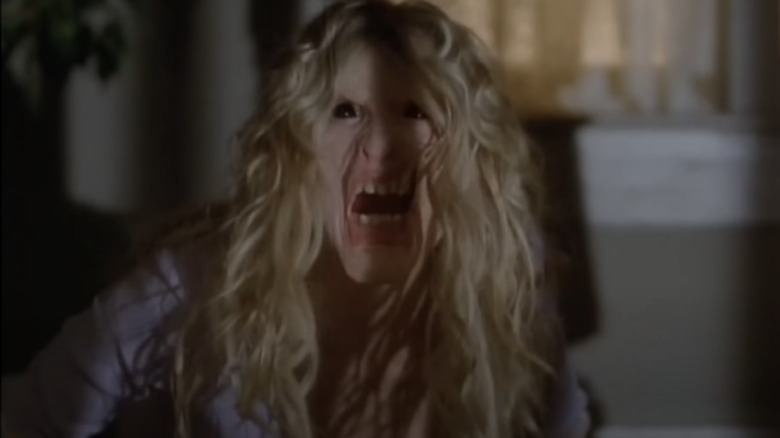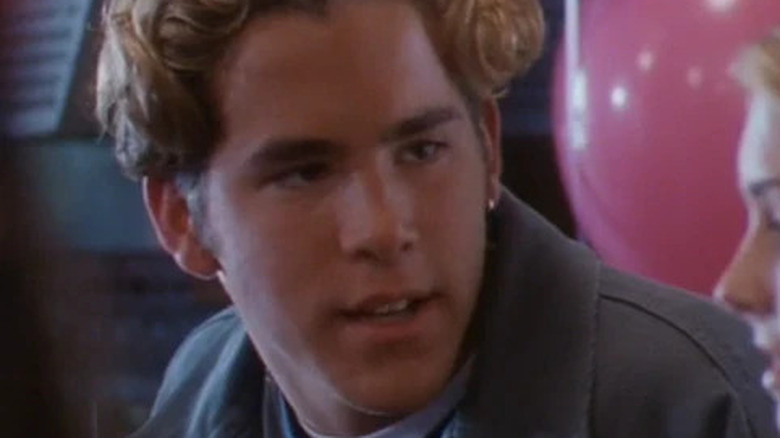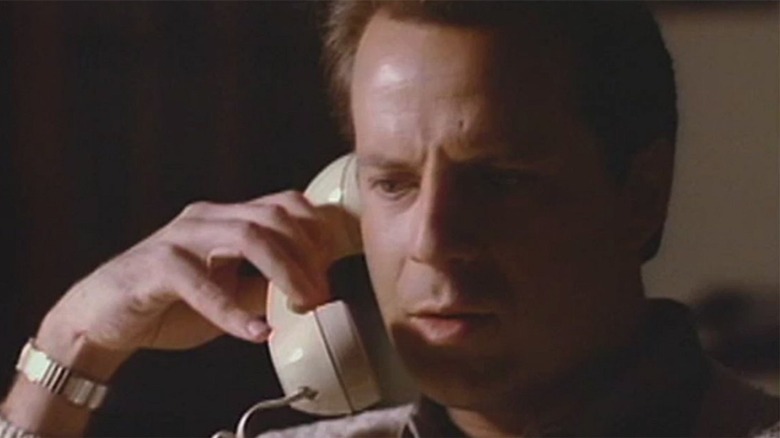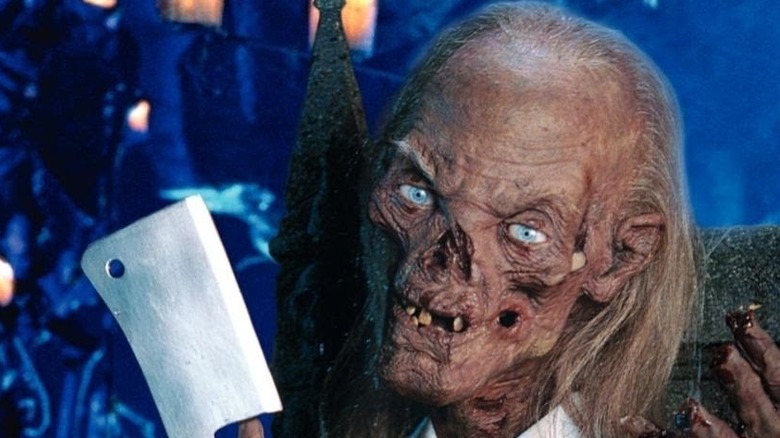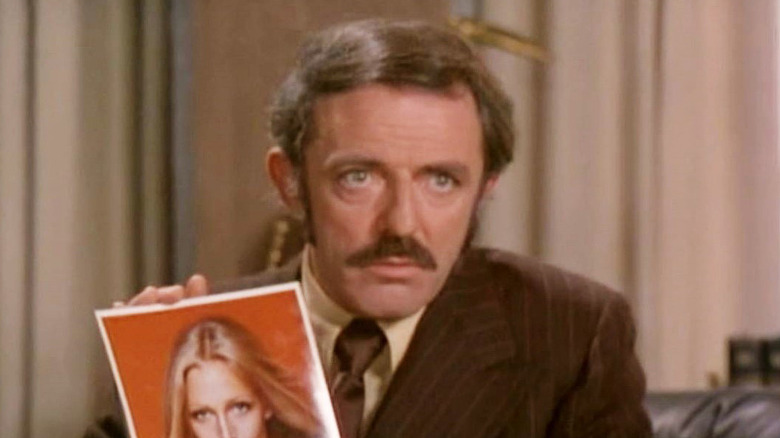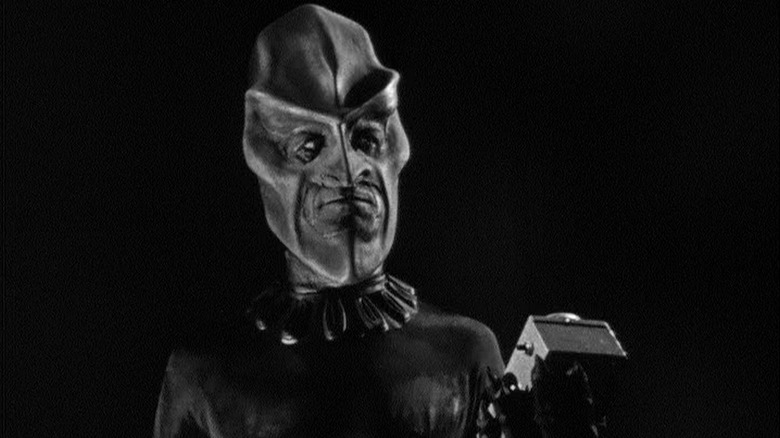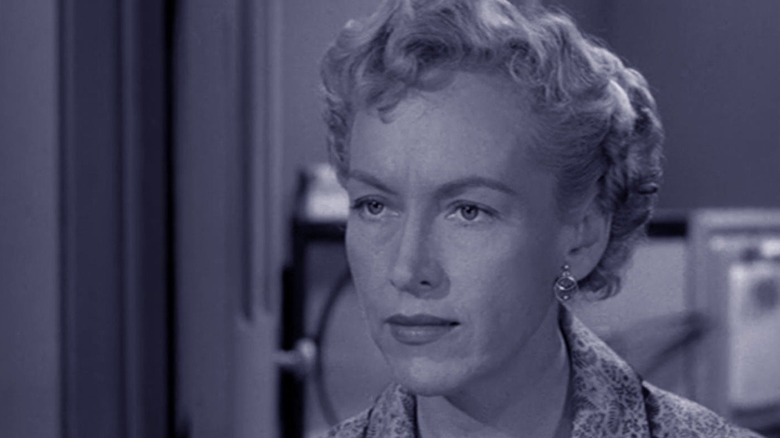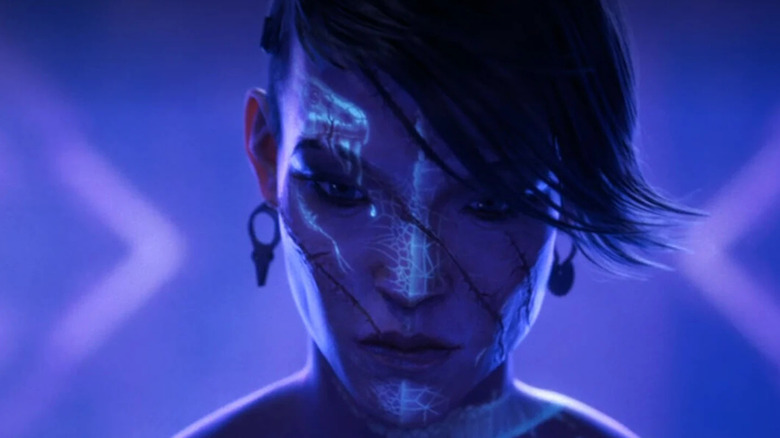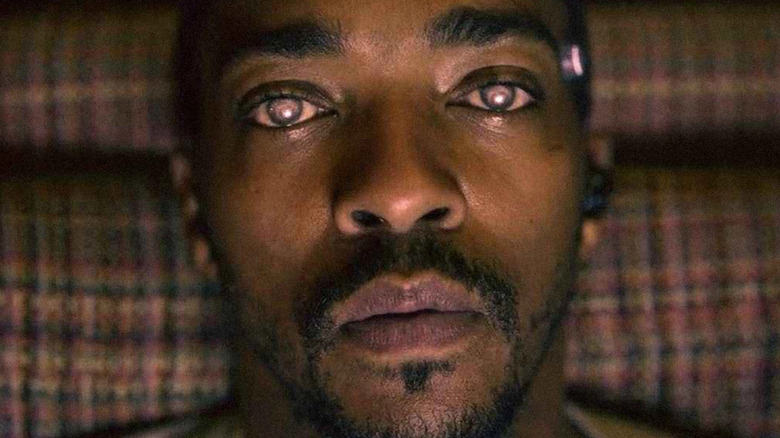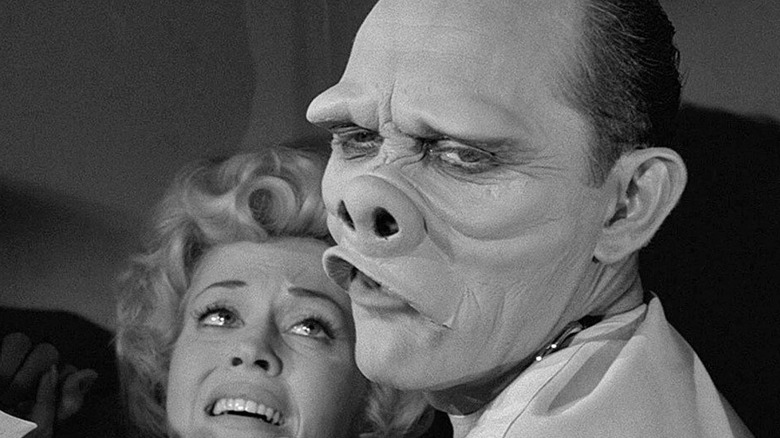The Best TV Anthologies Ranked According To IMDB
The television anthology show is almost as old as television itself. Presenting a different story each week, the best of these mixed-premise series would have a host — usually in the form of a charismatic singular personality — that would introduce each episode. In some cases the show would be built around an acclaimed filmmaker, or framed around the stories of a revered author who might also act as the narrator.
But in the early days there were few anthologies that were all that memorable, let alone anything as compelling as what we are used to today. They usually amounted to a short "movie of the week" with predictable stories, designed simply to distract you for 25 or 50 minutes once a week. Since that time, the anthology genre has seen a plethora of high quality shows, ranging from the fascinating to the truly bizarre — and often shocking — and some have found themselves sitting amongst the best television shows in history.
They are high concept series penned by some of the industry's best writers, whether original or adaptations; they attract high profile, award-winning talent in front of and behind the camera. The stories are richer, deeper, and intended to thrill, excite, or scare, and — at their best — leave you with something to think about before the next episode. From "The Outer Limits" to "Black Mirror," we've compiled a list of the best anthologies ever seen on television.
15. American Horror Stories (2021)
Debuting in 2021 was "American Horror Stories," a spinoff of the highly acclaimed series "American Horror Story." Whereas its parent show featured a new season-long tale each year with largely the same returning cast members, this new iteration of the franchise swaps out the annual adventures in favor of new stories every week. These self-contained episodes are in line with the more traditional anthology structure and help diversify the "AHS" universe. Well-written and stylishly executed, the series assembles the brand's usual high quality acting talents of big and lesser known names to produce even more thrills and chills for its fans.
The first season received split opinions among the franchise's diehard followers early on. Some called out its seeming reliance on older canon, as a number of episodes featured the return of several characters and settings from previous "American Horror Story" tales. The show received mixed reactions from critics too, but it's hard to deny that the series is well made and is more than capable of eliciting the same kinds of scares and screams for its audience as its predecessor. Most reviews agreed that, warts and all, it was a solid start to a new horror series. Fans also have more to look forward to thanks to a second season order already being confirmed, with series creator Ryan Murphy set to return to produce and oversee another year of new single episode horror stories.
14. Electric Dreams (2017)
Hollywood has long recognized the brilliance of noted science fiction author Philip K. Dick. A number of his stories and novels have been adapted to the screen, with a few — including "Blade Runner," "Minority Report," and "Total Recall" — considered all-time greats. So it's no surprise that in the aftermath of the success of "Black Mirror," Amazon Studios chose Philip K. Dick as the author around which to center a new science fiction show. Its title was inspired by the same novel that became "Blade Runner" ("Do Androids Dream Of Electric Sheep") and while it wasn't the first TV series to be adapted from his short stories — that would be Showtime's 1997 effort "Total Recall: 2070" — it was the only one with his name in the title.
The series adapted 10 stories by the author, while its cast was filled with big names including Bryan Cranston, Benedict Wong, Steve Buscemi, Terrence Howard, Anna Paquin, Richard Madden, Vera Farmiga, and Juno Temple, among others. Episodes like "The Hood Maker" and "Autofac" are standouts, the latter of which is an ironic send-up of an Amazon-like corporation that torments the remnants of society after an apocalypse. The show dips even more into true futurist, cyberpunk, and dystopian science fiction concepts than its rivals, but is less cynical as well. Despite strong writing and some trippy stories, it was largely overlooked upon its release, making this one of the most underrated anthology gems of the last decade.
13. Amazing Stories (1985)
When you're a network hoping to bring a hit TV series to the screen, you can't do much better than having a director like Steven Spielberg create it. Brought to life in 1985 off the back of his work on "The Twilight Zone" movie two years earlier, Spielberg's "Amazing Stories" was that series for NBC, and not only did the "Indiana Jones" director develop the fantasy anthology, he helmed two episodes himself. He also brought along many of his famous friends: the lengthy list of "Amazing Stories" directors included Robert Zemeckis, Martin Scorsese, Clint Eastwood, and Irvin Kershner.
With such high profile filmmakers involved, it wasn't difficult to attract A-list talent in front of the camera either, from Kiefer Sutherland and Charlie Sheen to Kevin Costner and John Lithgow, the latter of whom scored an Emmy for his work on the series. The series was also notable for its single animated episode, "Family Dog," written and directed by future Pixar great Brad Bird, alongside a young production designer named Tim Burton. The episode was such a big hit that it was spun off into its own series, with Burton serving as the show's executive producer.
With a mix of science fiction, fantasy, and horror, "Amazing Stories" delivered bizarre family-friendly tales that delighted audiences for two strong seasons, earning a cult following after its cancellation. It was revived in 2020 on Apple+, again produced by Steven Spielberg.
12. Tales From The Darkside (1983)
After the success his anthology movie "Creepshow," it's said that George A. Romero sought to bring the film to the small screen as a weekly series, but couldn't acquire the rights, leading him to start his own series under another name. Whatever the origins are, "Tales From The Darkside" was one of the most shocking and genuinely terrifying shows to air on television to that point, even if it did air in syndication and very late at night.
Like it's anthology forebearer "The Twilight Zone," Romero's "Tales From The Darkside" includes a chilling opening narration spoken in deep, ominous tones over a series of unsettlingly vague images that Felix Vazquez Jr. of horror outlet Bloody Disgusting recalled vividly even in 2020: "I was absolutely terrified of the opening credits ... When I say terrified, I mean running for cover and hysterically crying whenever the credits opened."
Premiering on Halloween weekend in 1983, the series delivered genuine frights in stories often adapted from works by horror icons like Stephen King, Clive Barker, Robert Bloch, and Romero himself, cast with a number of solid actors recognizable as '80s TV mainstays. It was clearly made on a budget, but it wears it flaws on its sleeve; at the end of the day its primary goal was to shock, scare, and disturb the audience, and at that it thoroughly succeeded.
11. Ray Bradbury Theater (1985)
With the success of horror shows like "Tales From The Crypt" and "Tales From the Darkside" in the early '80s, the middle of the decade saw a wave of science fiction anthologies hit the screen. While Warner Bros, the studio behind "Amazing Stories," focused on a lauded producer and director to drive their show — in their case Steven Spielberg — another studio went a different direction, instead opting to focus on an acclaimed writer.
Premiering the same year as "Amazing Stories" was another anthology series, "Ray Bradbury Theater." Hosted by acclaimed science fiction author Ray Bradbury, the show adapted 65 of his short stories for the series over the course of its six seasons on the air. The show was well received but not widely watched thanks to its confusing and odd broadcast history, specifically on cable channels that most homes didn't have in the mid-1980s. The first two seasons were aired on HBO, while seasons three through six aired on the USA Network. Still, the series boasted a strong stable of actors that included Jeff Goldblum, William Shatner, Drew Barrymore, and a long list of influential names.
With a pedigree like Bradbury's, it's not hard to understand why the show was a success, with several of his stories having already been adapted for episodes of "The Twilight Zone," "Tales Of Tomorrow," and "Alfred Hitchcock Presents" in the 1950s and '60s. One of the lesser heralded of the '80s anthologies, it's nonetheless one of the highlights of the era.
10. Masters of Horror (2005)
The early 2000s were not a great time for TV anthologies. A "Twilight Zone" revival in 2002 failed to deliver thrills or chills, and the long-running '90s "Outer Limits" reboot had come to a close after being shuffled off to the Sci-Fi Channel (which at that time was known more for low quality knockoffs). But Showtime had one gem that went under the radar for two seasons in 2005 and 2006: "Masters of Horror." It delivered just the kind of high quality stories that anthology fans were looking for, and if you were lucky enough to discover it, you were in for a real treat.
More about well-crafted and disturbing stories than mindless scares, "Masters of Horror" delivered some of the best-made horror on TV at the time. It had some of the most noted names in the genre behind the camera too, including John Carpenter, Tobe Hooper, John Landis, Dario Argente, and Joe Dante. It also included a tale by Takeshi Miike, who had yet to see American shores but who was a legend in his native Japan for his own brand of stylish horror movies like "Audition" and "Ichi the Killer." Miike's episode in fact proved so upsetting to the American studio that it was held back from broadcast, and wasn't seen until the DVD release. To this day, "Imprint" has never aired in the United States.
If you're a horror fan looking for a true forgotten treasure on this list, this is the one to look for. You won't be disappointed.
9. The Outer Limits (1995)
Often overlooked thanks to its classic older brother, the 1995 "Outer Limits" series was still a solid entry on its own merits. It opened its seven-season run on Showtime with a feature-length story from George R.R. Martin, and finished its final two seasons on the Sci-Fi Channel in 2002. That it received seven seasons should be testament enough to its quality, but it also was well cast, with many appearances that are surely included on "before they were stars" trivia lists. These included Josh Brolin, Ryan Reynolds, Kirsten Dunst, and Joseph Gordon Levitt.
Geared toward a more adult audience, the series had some incredibly high concept episodes, with ideas and stories that weren't just mind-bending and fun, but genuinely thought-provoking, often with a well-considered message. And despite it being a weekly anthology, the series even managed to work in a handful of ongoing subplots that would typically culminate at the conclusion of a season in a unique "part-clip show, part-crossover" finale.
The show never reached the quality of the original, but it was solid from start to finish, with a handful of truly memorable outings filled with disturbing and unsettling stories. With the benefit of 20 years' hindsight, history has been kind to this reboot, and fans have continued to rediscover it years after it ended.
8. The Twilight Zone (1985)
In 1985, the biggest name in the genre saw a revival with a new version of "The Twilight Zone" debuting that year. Brought back to television thanks to the success of "The Twilight Zone: The Movie" two years before, it was a surprisingly worthy successor to the original.
Kicking off its run with the impressive mind-bending psychological thriller "Shatterday," based on the short story by legendary sci-fi author Harlan Ellison, it tells the story of a man whose life is slowly taken over by an increasingly sinister doppelganger. The series grabbed audiences with smart writing and interesting stories, and though nobody had expected it to equal the original, it came darn near close. The series also included remakes of classic episodes like "Shadow Play" and "The After Hours," while creating its own gems like "A Little Peace And Quiet," "A Matter Of Minutes," and "Button Button," the latter also the basis for the 2009 film, "The Box." Also notable were the six episodes directed by Wes Craven, and writing contributions from the likes of J. Michael Straczynski, George R.R. Martin, and Richard Matheson, among many others.
In 2002 another relaunch of the "Twilight Zone" hit the airwaves, lasting two seasons. It had a few fine entries, but no "Twilight Zone" reboot has ever quite been able to come anywhere close the heights of the first two series. A fourth version, hosted by Jordan Peele, debuted in 2019 on CBS All Access and also ran for just two seasons.
7. Tales From The Crypt (1989)
Of all the '80s horror shows, most fans agree that "Tales From The Crypt" reigns supreme. One of the ways it stood out over its contemporaries was its unique treatment of the concept of the host, which took the idea of a narrator one step further than most with the "Cryptkeeper," a menacing ghoul and master of ceremonies that would introduce each story.
As much about suspense as it was about spooks, "Tales From the Crypt" excelled with stories of the macabre and the supernatural. Thanks to airing on premium cable, it was layered with loads of blood, gore, excessive violence, profanity, and nudity. This was decidedly and unapologetically not family entertainment. One of the few HBO shows from the era to break into the broader mainstream consciousness thanks to its controversial content, the series was essentially a "modern" update to "The Twilight Zone" that amped up the intensity for '80s audiences watching slasher flicks and adult horror movies.
As for the talent the show attracted, it was a who's who of iconic actors and directors, as well as high-profile composers. It also gave several A-list Hollywood stars the chance to direct, including the likes of Michael J. Fox, Tom Hanks, and even Arnold Schwarzenegger. With a memorable theme by Danny Elfman, and some spine-chilling twist endings, this one remains as can't-miss as they come.
6. Night Gallery (1969)
Just four years after the sudden and surprising cancellation of the legendary CBS anthology "The Twilight Zone," series creator Rod Serling would develop a new show for rival NBC. In addition to hosting duties, the TV icon Serling also contributed many scripts, so it should come as no surprise to learn that "Night Gallery" proved to be a worthy follow-up.
With an opening set in an art museum full of unusual paintings, Serling would begin each episode by approaching a piece and using it as the entry into the episode. It was a unique way of drawing in the viewer each week, giving it a signature starting point that helped set it apart from his former show. But with the kind of stories it offered and Serling acting as host, it might have been easy for audiences at home to view the series as an extension of "The Twilight Zone," with the biggest difference being that it was in color.
Like many shows on this list, "Night Gallery" was swimming in Hollywood stars, but what may be most noteworthy is that the pilot episode included the first professional credit for a young director named Steven Spielberg. Though "Night Gallery" was never quite as clever as Serling's prior beloved masterpiece, there were many episodes with such imaginative premises as a clairvoyant diary and a soul-stealing magician.
5. The Outer Limits (1963)
Often considered as the top dog of anthology shows, few would disagree that "The Outer Limits" is at least among the very best of the genre, with many of its episodes, characters, and catchphrases permanently imprinted on the public consciousness.
Though often compared to "The Twilight Zone," which debuted four years prior, "The Outer Limits" was overall a much darker show, and less family friendly, with quite a few more genuine scares. It replaced the warm, welcoming Rod Serling with the deeper, creepier tones of "the control voice" that opened and closed each episode. Stories were much more horror-focused, with some calling it a "monster of the week" show. But that description doesn't do it justice, as it undersells the brilliant storytelling at the heart of the series that made it compelling and enduring. While it did include the odd lighthearted episode, most tales examined relevant social issues important to the day, while using bizarre characters, alien protagonists — and yes, often monsters — as a conduit through which to channel ethical and moral lessons.
Despite only running for a brief two seasons, it received widespread acclaim and is often hailed as one of the best science fiction shows in television history. No matter where you rank "The Outer Limits," its indelible legacy can hardly be understated.
4. Alfred Hitchcock Presents (1955)
Alfred Hitchcock had one of the most impressive careers in Hollywood, and his groundbreaking films forever changed the way movies were made. He had similar impact on television too, with "Alfred Hitchcock Presents." More than 65 years after its debut, it's not hard to see why it was one of the highest rated shows of its day, and ran far longer than any other series on this list.
Hosted by Hitchcock himself, who was already one of Hollywood's most famous directors, the series was one of the first to be named solely in honor of its host rather than a product sponsor (a common tactic that included "Buick-Electra Playhouse" and "Colgate Theater"). With its iconic opening and Hitchcock's famous "good evening" greeting, the writer-producer-director as host would be repeated by many shows that would follow.
The half-hour episodes spanned a variety of tones and subject matter, but were mostly mystery and suspense stories — Hitchcock's bread and butter — with the director helming 17 segments himself. Stories took standard plots and tropes and managed to elevate them, putting a new spin on stories the audience thought would be safe and familiar. The show also took the subject matter a lot more seriously than many of its contemporaries, delivering intense drama rather than what usually amounted to a short televised play. In its own way, "Alfred Hitchcock Presents" was as groundbreaking as many of the master's films.
3. Love, Death and Robots
"Love, Death and Robots," unlike every other show on this list, is an animated series; but despite its sometimes cartoonish style, it is most definitely for adults only. Birthed by two high-profile producers, David Fincher ("Mindhunter") and Tim Miller ("Deadpool"), it might be easy to guess the tone a series from those two minds might take. Most episodes — comprised of five-to-15-minute shorts — are stunning on a variety of levels, whether due to an avant garde premise or jaw-dropping visuals.
A spiritual successor to the likes of "Heavy Metal" and MTV's "Liquid Television," the sci-fi anthology blends high quality CGI, rotoscoping, 2D, and mixed media animation. Some of the shorts feel as much like video game cut scenes as dramatic adult animation, but Fincher and Miller seem well aware of the format's strengths and limitations, and use them to their advantage. While the celebrated visuals of "Love, Death and Robots" are at the center of its appeal, that's not to say the stories aren't impressive too.
Filled with a variety of psychedelic weirdness and surrealist science fiction that we couldn't even begin to describe without reviewing each episode in detail, the show presents intense stories with real emotional weight. Elevating what could have been a flighty series concept, "Love, Death and Robots" has a style and scope that makes it truly a treasure to behold and is guaranteed to leave you breathless.
2. Black Mirror (2011)
Author, screenwriter, producer, and satirist Charlie Brooker had been a newspaper columnist for years and had appeared all over British television on comedy panel shows like "8 Out of 10 Cats," "The Big Fat Quiz of the Year," and "Would I Lie To You?" A gifted comic and astute social commentator (think a UK Jon Stewart if you've never seen his prior work), Brooker took a surprise turn in 2011 when he created the science fiction anthology series "Black Mirror."
Described by GQ magazine as "if Hitchcock made 'The Twilight Zone,'" the series was set apart from other similar shows past and present by having a clear thematic focus on technology. Dripping with social commentary, "Black Mirror" is appropriately titled, as stories like "White Bear" and "Nosedive" hold up a mirror to society that reflects our darker impulses when it comes to technological progress. Since its debut the show has recruited some serious Hollywood talent, from Anthony Mackie and Miley Cyrus to Jon Hamm and Bryce Dallas Howard. Actors and audiences alike are drawn to the show thanks to its intelligence, wit, and just plain brilliant writing that challenged viewers with thoughtful scripts and unique ideas.
Tragic, foreboding, maybe even a little sardonic, "Black Mirror" stories "are not warnings" about the dangers of technology, said Brooker to The Independent, but a statement: the kind of progress seen in the series, he says, "is inevitable."
1. The Twilight Zone (1959)
The stylish "one-hour drama of the week" had been popular on television for years, with notable shows like "Fireside Theater" and "Playhouse 90" presenting audiences with a new story each week. But in 1959, writer Rod Sterling created "The Twilight Zone," a twist on the format unlike anything American television audiences had ever seen before.
Serling, known for his sharp scripts, presented CBS with a pilot for a new anthology series in 1958 titled "The Time Element," about a man who's transported back in time to Pearl Harbor just before the Japanese attack in 1941, unable to convince anyone that an attack is imminent. This was Serling's first time working in science fiction, and with it he planted the seed of what was to become "The Twilight Zone."
Running for five seasons and 156 episodes, "The Twilight Zone" mixed every genre, including science fiction, horror, fantasy, and comedy. But at the center of every segment was a high quality story mixed with a dash of the bizarre, and almost always a twist at the end or a lesson for the viewer to learn. Often imitated, "The Twilight Zone" was adapted into a film in 1983 and relaunched three times. Countless anthology copycats have followed — some successful, most not — but none have come close to matching the genius of Serling's original.
